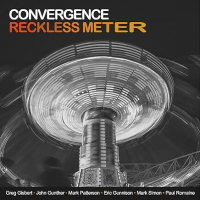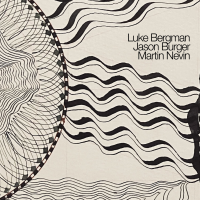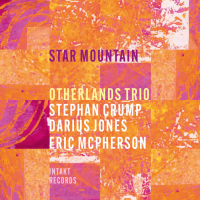Home » Jazz Articles » Album Review » Tom Pierson: Last Works
Tom Pierson: Last Works
A soloist in the Houston Symphony Orchestra at the young age of 13 and subsequently a student at Julliard School in New York, Pierson spent his days studying and performing the great jazz songbook in detail before moving to Japan in the early nineties, where he has made a home for himself up to the present. His own Tom Pierson Orchestra is made up of young talents as well as veteran professionals on the scene who interpret his scores with passion and vigor.
Two general types of arrangements can be traced across this twelve-tune set (plus an additional encore). On the one hand those that put the orchestral sonic wall on the forefront, and on the other hand demonstrations that are more focused around the core rhythm section—made up of Pheeroan AkLaff's ferocious drum chops, Yokohama-native but California- raised Kanoa Mendenhall plucking the bass and the composer, Pierson himself, affectionately handling piano duties. Charts such as "Chandra Lowery's Samba" and "By the Martyrs Decree" can be attributed to the latter sort and see the three tightly bouncing back on one another's driven impulses while saxophone, trumpet and trombone each are handed the reigns for lush soloing. The highly transparent recording and tidy production on this album allow each member of the orchestra to shine through as an individual musical force, making it possible to marvel at each instrumentalist even in the densest of sections, as displayed on the heavily packed "times remembered."
According to Pierson, the compositions spread over the two-disc set "span over 40 years of [his] search for beauty." Consequently, the sheer variety of compositional styles and arrangements at hand doesn't come as a surprise and makes the just over two-hour endeavor a truly impressive tour de force that seems to offer something new at every turn. It goes by in a whiff, leaving the listener's ears ringing with melodies, changes and emotions that last for days. His tendency for writing longer forms and more complex structures leaves even single compositions invoke entire journeys. With five pieces clocking in at well over ten minutes— some among them at just under twenty—Pierson truly isn't greedy when it comes to offering up said journeys. In the booklet he justifies: "When I formed my big band at the end of the 70s, I thought the future of jazz lay in improvisation over more extended compositional forms, a way to escape the constant repetition of choruses." True to the words of younger Pierson, the lack of repetition in senior Pierson's oeuvre comes as a welcome change in the world of jazz orchestras.
But length doesn't have to equal work, in the sense that Pierson's more elaborate compositions don't always compulsively entail strings of complexity or crowds of motifs. Samba shuffles as found on "winter's end" loosen the atmosphere and give way to some of the brass and reed highlights of the album while the first set closer "the pharaoh's serpent" sounds like the orchestral scoring of a track King Crimson never wrote in the mid 70s. A heavily syncopated melody is slowly but determinedly harmonized over a five minute exposition before things quieten down and bass and drums create an airy foundation for saxophones to soar to.
The second set continues down the same path of alternating lengths, compositional forms and constantly changing proportions in arrangement. "Elipsis" is a fatly stacked wake-up call that fuses the dexterous rhythm section with thickly layered brass and reed sections to outstanding coherence, only to subsequently have "sultry" contrast the energetic exposition with calmness and ease. "45/8" as well as "two becoming 3" embrace the more dissonant nature between harmony and disharmony and expose the avant-garde leanings of Pierson's compositional approach. "Among Strangers" is a fittingly anticlimactic finale demonstrating what must belong to the most dynamic crescendos followed by a decrescendo ever put to "tape."
Tom Pierson's Last Works is clearly a testament to the love of jazz, big bands and orchestras as well as music and musicians in general and presents a composer, pianist and arranger who has evidently been a quiet giant for some time. The emphasis being on "giant."
Track Listing
Abandoned; Chandra Lowery's Samba; By The Martyr's Decree; Times Remembered; Winter's End; Dark Story; The Pharaoh's Serpent; Elipsis; Sultry, 45/8; In God's Name; Two Becoming 3; Among Strangers.
Personnel
Lou Marini: saxophone, woodwinds; Mark Vinci: saxophone, woodwinds; Stu Enomoto: saxophone, woodwinds; Neil Johnson: saxophone, woodwinds; Michael Lutzeier: saxophone, woodwinds; Dominic Degrasse: trumpet; Mike Ponella: trumpet; Tim Leopold: trumpet; Lew Soloff: trumpet; Ben Herrington: trombone; Robinson Khoury: trombone; Dan Levine: trombone; Jeff Nelson: trombone; Tom Pierson: piano; Kanoa Mendenhall: electric bass; Pheeroan Aklaff: drums.
Album information
Title: Last Works | Year Released: 2018 | Record Label: Self Produced
Tags
PREVIOUS / NEXT
Support All About Jazz
 All About Jazz has been a pillar of jazz since 1995, championing it as an art form and, more importantly, supporting the musicians who make it. Our enduring commitment has made "AAJ" one of the most culturally important websites of its kind, read by hundreds of thousands of fans, musicians and industry figures every month.
All About Jazz has been a pillar of jazz since 1995, championing it as an art form and, more importantly, supporting the musicians who make it. Our enduring commitment has made "AAJ" one of the most culturally important websites of its kind, read by hundreds of thousands of fans, musicians and industry figures every month.





















